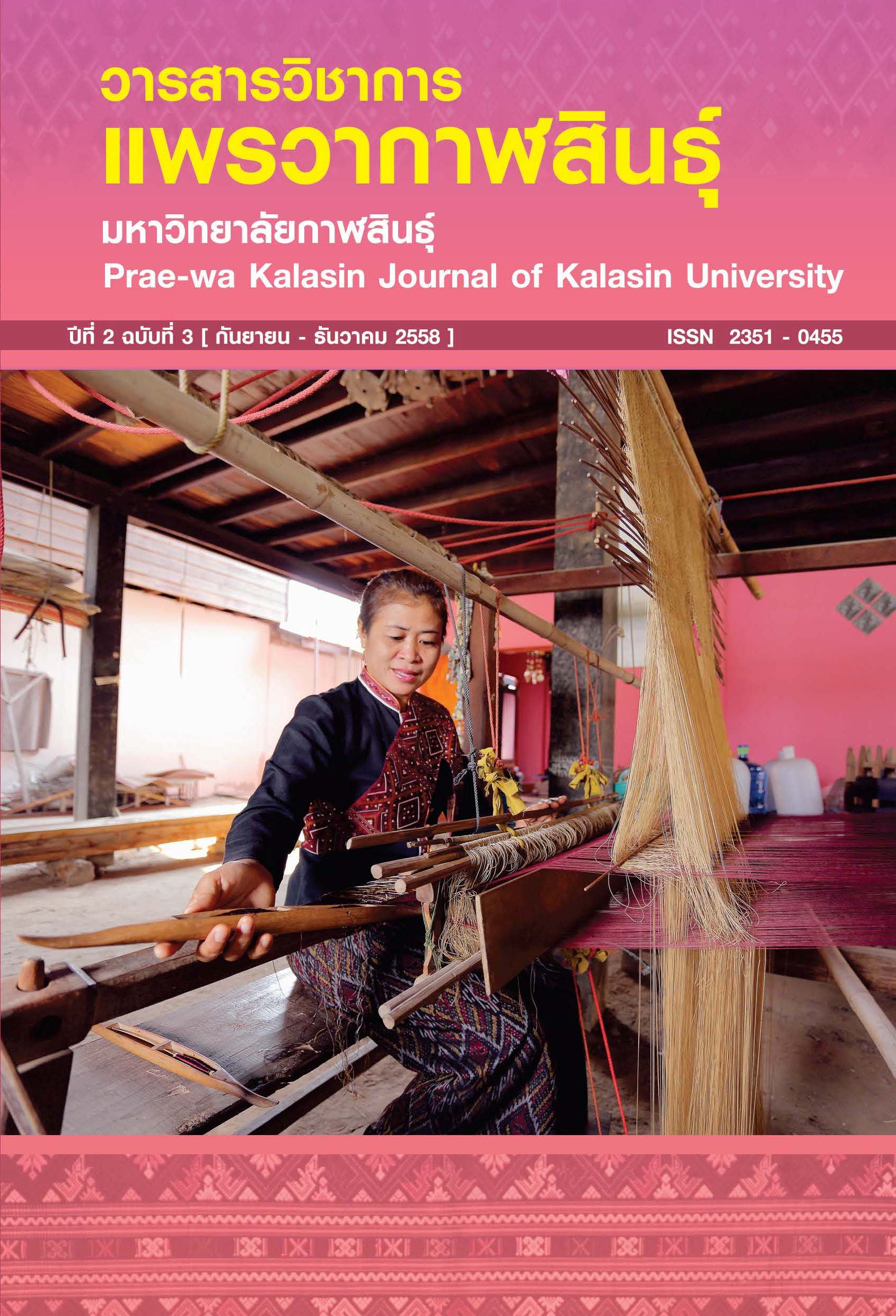A Study of Current State of Educational Management for ASEAN by Institutions Affiliated with Kalasin Primary Educational Service Area Office 3
Main Article Content
Abstract
การวิจัยนี้มีวัตถุประสงค์เพื่อ 1) ศึกษาสภาพการจัดการศึกษาเพื่อการจัดการเรียนรู้สู่ประชาคมอาเซียนของสถานศึกษาในสังกัดสำนักงานเขตพื้นที่การศึกษาประถมศึกษากาฬสินธุ์ เขต 3 2) เปรียบเทียบสภาพการจัดการศึกษาเพื่อการจัดการเรียนรู้สู่ประชาคมอาเซียนของสถานศึกษาในสังกัดสำนักงานเขตพื้นที่การศึกษาประถมศึกษากาฬสินธุ์ เขต 3 จำแนกตามขนาดของสถานศึกษา และ 3) ศึกษาแนวทางการพัฒนาการจัดการศึกษาเพื่อการจัดการเรียนรู้สู่ประประชาคมอาเซียนของสถานศึกษาในสังกัดสำนักงานเขตพื้นที่การศึกษาประถมศึกษากาฬสินธุ์ เขต 3 ประชากรคือผู้บริหารสถานศึกษาและครูผู้สอน จำนวน 2,265 คน กลุ่มตัวอย่าง คือ ผู้บริหารสถานศึกษา และครูผู้สอนจำนวน 328 คน โดยการสุ่มแบบแบ่งชั้น และผู้ทรงคุณวุฒิจำนวน 9 คน โดยการเลือกแบบเจาะจง เครื่องมือที่ใช้ในการวิจัยเป็นแบบสอบถามและแบบสนทนากลุ่มสถิติที่ใช้ในการวิเคราะห์คือ ค่าเฉลี่ย ร้อยละ ส่วนเบี่ยงเบนมาตรฐาน ผลการวิจัยพบว่า 1) สภาพการจัดการศึกษาเพื่อการจัดการเรียนรู้สู่ประชาคมอาเซียนของสถานศึกษาโดยรวมอยู่ในระดับมาก ( ) = 3.62 2) เปรียบเทียบสภาพการจัดการศึกษาเพื่อการจัดการเรียนรู้สู่ประชาคมอาเซียน พบว่า สถานศึกษาที่มีขนาดต่างกันมีสภาพการจัดการศึกษาเพื่อการจัดการเรียนรู้สู่ประชาคมอาเซียนโดยรวมแตกต่างกัน 3) แนวทางการพัฒนาการจัดการศึกษาเพื่อการจัดการเรียนรู้สู่ประชาคมอาเซียนของสถานศึกษาคือ หน่วยงานที่เกี่ยวข้องควรให้ความร่วมมือด้านการบริหารจัดการการกำหนดแผน กลยุทธ์และ สร้างความรู้ความเข้าใจโดยเน้นที่สถานศึกษาขนาดเล็ก
) = 3.62 2) เปรียบเทียบสภาพการจัดการศึกษาเพื่อการจัดการเรียนรู้สู่ประชาคมอาเซียน พบว่า สถานศึกษาที่มีขนาดต่างกันมีสภาพการจัดการศึกษาเพื่อการจัดการเรียนรู้สู่ประชาคมอาเซียนโดยรวมแตกต่างกัน 3) แนวทางการพัฒนาการจัดการศึกษาเพื่อการจัดการเรียนรู้สู่ประชาคมอาเซียนของสถานศึกษาคือ หน่วยงานที่เกี่ยวข้องควรให้ความร่วมมือด้านการบริหารจัดการการกำหนดแผน กลยุทธ์และ สร้างความรู้ความเข้าใจโดยเน้นที่สถานศึกษาขนาดเล็ก ) = 3.62 2) the comparison of educational management for ASEAN of the institutions have revealed that the overall educational management for ASEAN are relevant to the sizes of the institutions and 3) the way to develop the educational management for ASEAN is to let the relevant institutes or sectors to assist in managing, strategic planning and to provide knowledge and understanding to the smaller educational institutes.
) = 3.62 2) the comparison of educational management for ASEAN of the institutions have revealed that the overall educational management for ASEAN are relevant to the sizes of the institutions and 3) the way to develop the educational management for ASEAN is to let the relevant institutes or sectors to assist in managing, strategic planning and to provide knowledge and understanding to the smaller educational institutes.
The objectives of this study are to 1) study of current state of the Educational Management for ASEAN of Kalasin Primary Educational Service Area Office 3, 2) to of educational management for ASEAN of Kalasin Primary Educational Service Area Office 3, by dividing the institutions into groups according to the size of the institutions and 3) to study the course for the development of educational management for ASEAN of Kalasin Primary Educational Service Area Office 3. The population of the test were managers and teachers of the institutions with the number of 2,265 people. The sample group were 328 managers and teachers within the institutions by using stratified sampling and an additional group of 9 experts selected by purposive sampling. The tools used in this study were questionnaires and group discussions. The statistical methods used in the analysis were averages, percentages and normal distribution patterns. The results of the study revealed that 1) the overall current state of educational management for ASEAN of the institutions were in a high level (
Article Details
Section
Articles (บทความ)

